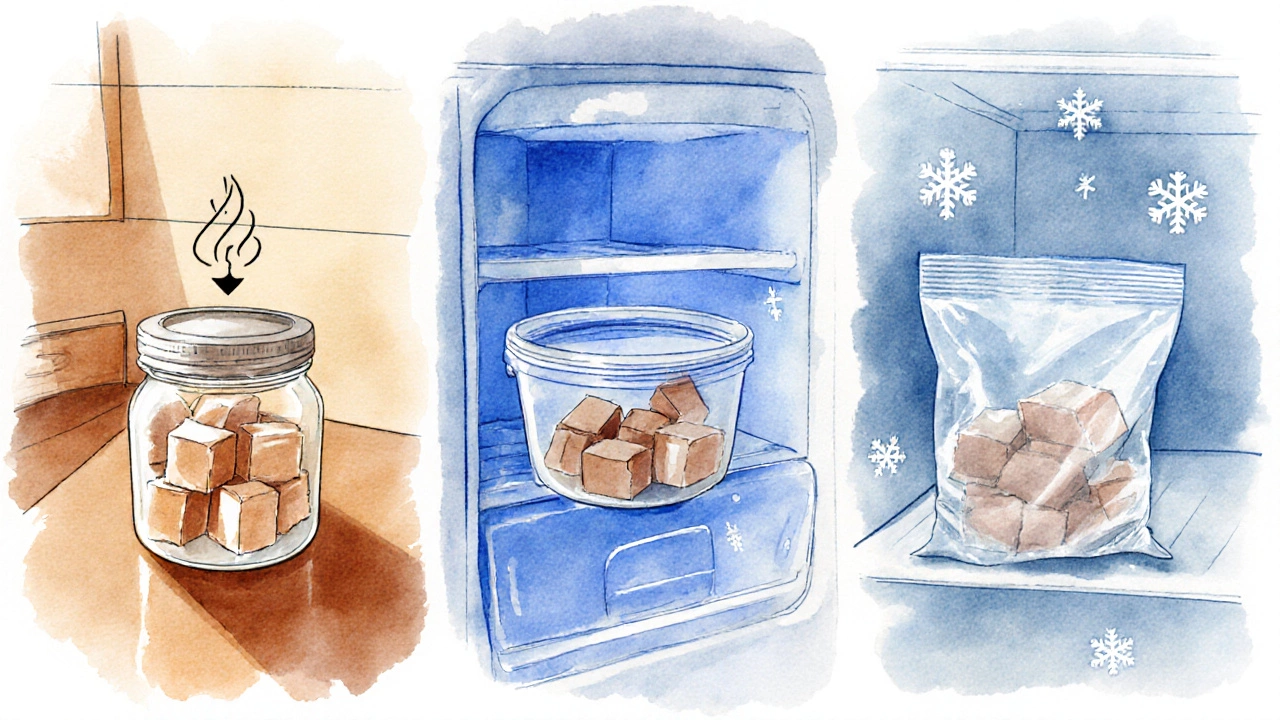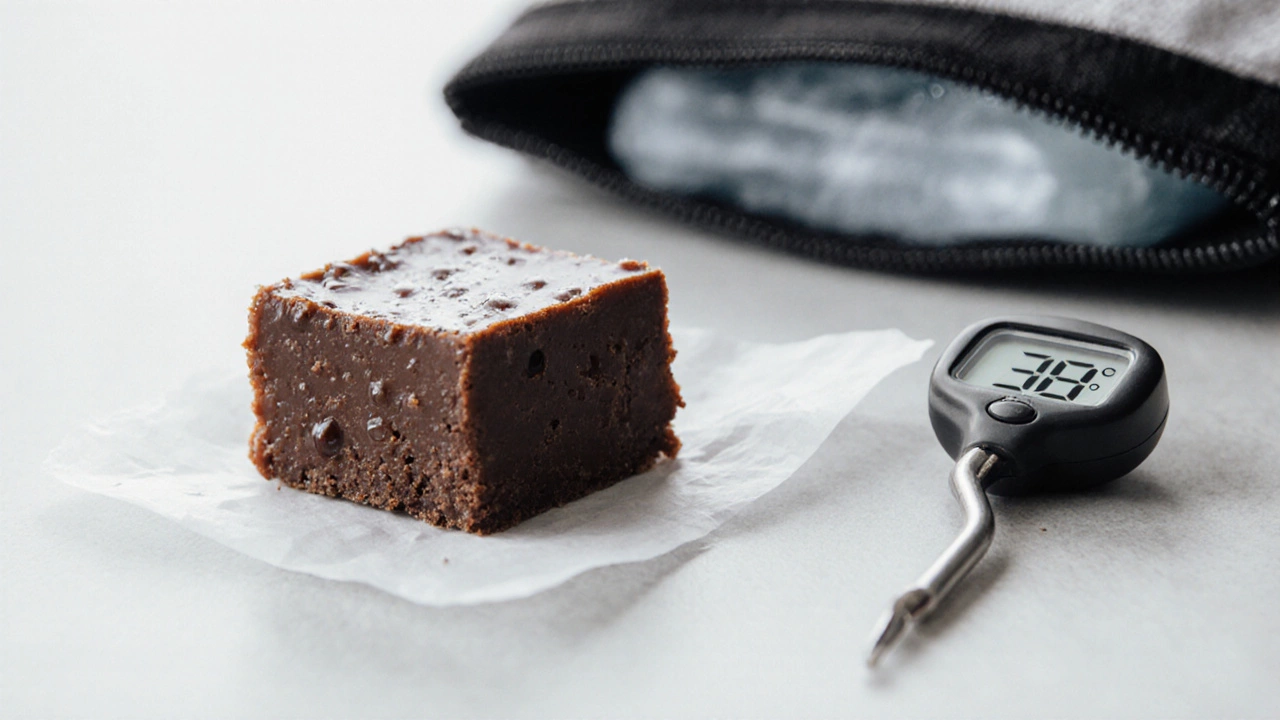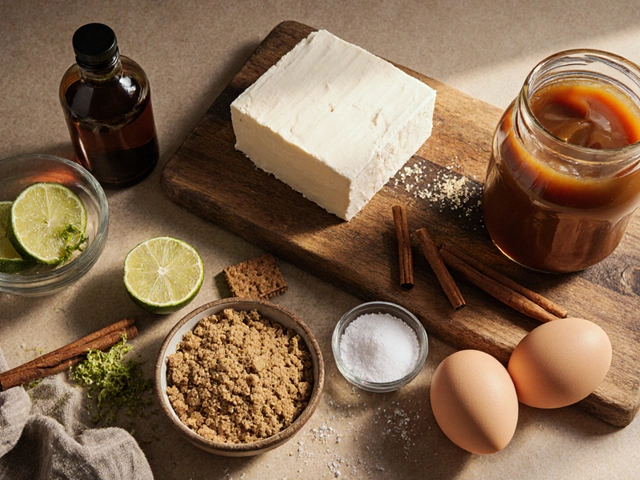
Fudge Storage Guide
Enter your fudge ingredients and storage duration to see the recommended storage method and shelf life.
Storage Recommendations
Room Temperature
1-3 days (dairy-free)
Best for quick consumptionRefrigerated
7-10 days (dairy-based)
Ideal for giftsFrozen
2-3 months (any type)
Long-term storageKey Takeaways
- Fudge can be kept at room temperature for up to 3 days if it’s made without dairy.
- When milk, cream, or butter are in the recipe, refrigerate to prevent spoilage.
- Storing in an airtight container slows moisture loss and keeps texture smooth.
- Freezing extends shelf life to 2-3 months without sacrificing flavor.
- Watch for off‑smell, discoloration, or a sticky surface as signs of spoilage.
When you hear the phrase homemade fudge is a soft, sugar‑rich candy made by heating sugar, butter, and milk to the soft‑ball stage and then beating it until creamy. It’s a classic treat that many bake on a whim, but the question that pops up in every kitchen is: Do I have to stick it in the fridge?
What makes fudge different from other candies?
Fudge sits in a sweet spot between candy and cake. Its texture comes from three main ingredients: sugar (usually granulated), butter, and a dairy component such as milk or cream.
The high sugar concentration creates an environment where most bacteria struggle to grow, but the dairy adds moisture and a protein base that can spoil if left warm for too long. That’s why the storage method hinges on whether your recipe includes dairy.

Do you really need to refrigerate fudge?
The short answer: it depends on the recipe. If you’ve made a classic chocolate fudge with butter, milk, and cream, treat it like any other dairy‑based product - keep it cool. If you’ve whisked together only sugar, butter, and a non‑dairy flavoring (like cocoa powder and vanilla), you can safely store it at room temperature for a few days.
Why? Sugar acts as a preservative by binding water, which lowers the water activity (aw). Lower aw means microbes can’t multiply quickly. But dairy raises aw enough that, at room temperature, pathogens like Listeria can eventually grow if given time.
Best ways to store homemade fudge
Choose a storage method that matches your recipe’s ingredients and how long you plan to keep the fudge.
| Method | Ideal Temp | Shelf Life | Texture Impact | When to Use |
|---|---|---|---|---|
| Room Temperature | 68‑72°F (20‑22°C) | 1‑3 days (dairy‑free) | Soft, creamy | Quick consumption, dry climate |
| Refrigerated | 35‑40°F (2‑4°C) | 7‑10 days (dairy) | Firm, may need a few minutes at room temp to soften | Any dairy‑based fudge, gifting |
| Frozen | 0°F (-18°C) | 2‑3 months (any) | Maintains texture when thawed slowly | Batch‑making, long‑term storage |
Regardless of the method, always use an airtight container. Plastic tubs with snap‑lids or glass jars with tight seals work best. This prevents the fudge from absorbing odors and keeps a moist environment from forming on the surface.
How long will fudge stay good?
Here’s a quick guide based on typical ingredient mixes:
- Dairy‑free fudge (sugar, butter, cocoa, vanilla): Up to 3days at room temp, 2weeks refrigerated, 3months frozen.
- Classic chocolate fudge (sugar, butter, milk, cream): 1‑2days at room temp (not recommended), 7‑10days refrigerated, 3months frozen.
- Nut‑infused fudge (adds nuts or dried fruit): Extra moisture from nuts shortens room‑temp shelf life; follow dairy guidelines and add a week when refrigerated.
Remember, these are estimates. Humidity, kitchen temperature, and how clean your utensils are can shift the timeline.

Spotting spoilage: when to toss the fudge
Even with a perfect storage plan, something can go wrong. Look out for these red flags:
- Off‑smell: A sour, yeasty, or rancid odor signals bacterial growth or butter oxidation.
- Discoloration: Pink or gray patches often mean mold or oxidative changes.
- Sticky surface: Excess moisture on the top can indicate condensation issues, which encourages mold.
- Texture shift: If it becomes grainy or overly hard after a short time in the fridge, it may be drying out and losing its creamy quality.
If any of these appear, discard the piece-food safety first.
Serving and transporting fudge safely
When you’re ready to share your creation:
- Take the fudge out of the fridge 20‑30minutes before serving. This lets it soften without melting.
- For picnics or parties, pack it in a cooler with an ice pack if the ambient temperature is above 70°F (21°C).
- Use parchment paper squares when cutting. It prevents sticking and makes portion control easy.
- If you need to move frozen fudge, let it thaw in the fridge overnight, then bring it to room temperature shortly before serving.
Frequently Asked Questions
Can I leave fudge out overnight?
If the recipe is dairy‑free, an overnight stay (about 12hours) at a cool room temperature is usually safe. For any recipe that contains milk, cream, or butter, it’s best to refrigerate after a few hours.
Will freezing change the flavor of fudge?
Freezing locks in flavor very well. The key is to wrap the fudge tightly in plastic wrap before placing it in a freezer‑safe container. When you thaw it slowly in the fridge, the taste stays virtually the same.
Do I need a special container for fudge?
A simple airtight container works fine. Glass jars, plastic tubs with snap‑lids, or zip‑lock bags (with the air squeezed out) keep the fudge from drying and protect it from other foods’ odors.
What temperature should I set my fridge to for fudge?
Aim for 35‑40°F (2‑4°C). That’s cold enough to slow bacterial growth but not so cold that the fudge freezes.
Can I use honey instead of sugar in fudge?
Honey is sweeter and has a higher moisture content, which can keep fudge softer but also reduces shelf life. Treat honey‑based fudge like a dairy‑free recipe: store at room temperature for a day or two, then refrigerate if you want it to last longer.












Write a comment